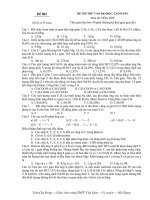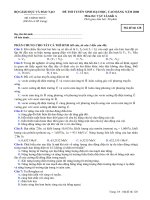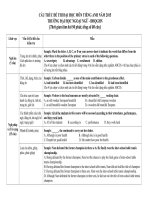- Trang chủ >>
- THPT Quốc Gia >>
- Hóa
De thi dai hoc nam 2014 lan 2 mon hoc hoc cua Nhat Ban
Bạn đang xem bản rút gọn của tài liệu. Xem và tải ngay bản đầy đủ của tài liệu tại đây (508.71 KB, 12 trang )
(liter)
0◦ C 1.0 × 105 Pa (=1.0 atm)
(standard state)
(ideal gas)
22.4 L/mol
(molar volume)
R = 8.31 × 103 Pa·L/(K·mol)
(gas constant)
(Avogadro constant)
NA = 6.0 × 1023 /mol
(Faraday constant)
F = 9.65 × 104 C/mol
(atomic weight)
1
L
(periodic table)
1
H 1.0
C 12
Cu 64
Br 80
(first period)
N 14
4
O 16
Mg 24
Cl 35
(element)
4
K
1
Al
K
Fe
(main group element)
(alkaline earth metal)
(transition element)
He
F
(
first ionization energy)
(electronegativity)
1
(covalent crystal)
2
2
BaSO4
CaO
(pyrite) FeS2
3
CO2
O2
SiO2
(reaction formula)
(coefficient) x
3
5
y Fe2O3 + SO2
11
12
7
(density)
4
4 FeS2 + xO2
14
1.25g/L
4
CH4
CO2
H2
2
N2
O2
5
(volume)
100mL
C2H2O4
(volumetric flask)
100mL
g
(a)
0.10mol/L
(marked line)
(b)
5
g
0.90
a
0.90
b
9.0
a
9.0
b
90
a
90
b
3
6
CH3OH
CO
(catalyst)
H2
(thermochemical equation)
CO(
) + 2 H2 (
)
CH3OH(
) + 92 kJ
(equilibrium state)
6
(forward reaction)
(reverse reaction)
mol
(equilibrium)
4
1 1
A
7
B
7
A
CH3COOHaq
0.050mol/L
(degree of electrolytic dissociation) 0.020
B
NaOHaq
0.10mol/L
A
pH
4
B
pH
12
A 20mL
B 10mL
pH
A
100
pH
2
B
100
pH
2
7
(oxidation-reduction reaction)
8
8
2 KMnO4 + 5 H2O2 + 3 H2SO4
H2O2
O
H2O2
2mol
KMnO4
H2SO4
2 MnSO4 + 5 O2 + 8 H2O + K2SO4
(oxidation number)
−1
0
(oxidizing agent)
KMnO4
5mol
H2O2
10mol
Mn
(acidity)
5
(electron)
(platinum electrode)
9
3860
(electrolysis)
(II)
CuSO4aq
(cathode)
0.25A
(electric current)
(mass)
9
g
H2
0.0020
H2
0.010
Cu
0.064
Cu
0.32
O2
0.016
O2
0.080
6
KNO3
10
100g
60◦ C
50g
(solubility)
(solute)
g
10◦ C
50g
(deposit)
g
10 g
4.4
16
39
7
46
78
(halogen)
11
11
(halogen atom)
(oxidation number)
(valence electron)
Cl2
H2
Cl2
(a)
12
Br2
7
(normal temperature)
F2
(oxidizing power)
F2
−1
I2
(normal temperature and pressure)
(e)
Cl2
SO2
12
(a)
(b)
(IV) MnO2
Fe
(c)
conc.HCl
dil.H2SO4
(II) FeS
NaCl
(d)
(e)
conc.H2SO4
NaHSO3
Cl2
SO2
a
b
a
c
a
e
d
b
d
c
d
e
8
(atom)
13
(oxidation number)
13
NH3
H2SO4
(a)
14
FeCl3
0.01mol/L
(d)
K2CrO7
0.01mol/L
KMnO4
CuSO4aq
(II)
(precipitate)
14
( a ) BaCl2
a
15
8.0g
b
( c ) NaCl
(b) H2S
a
c
Mg
a
0.50mol/L
d
b
(d) ZnCl2
c
b
HClaq 500mL
d
c
d
H2
L
15 L
2.8
3.7
5.6
9
7.4
15
(molecular formula) C5H10
16
(chain hydrocarbon)
(isomer)
(cis-trans
isomer)
16
5
6
7
8
(alkene) A
17
(product)
Cl2
A
(mass)
Br2
9
(addition reaction)
A
140g
A
460g
(number of carbon
atoms)
17
4
5
6
7
10
8
9
(structural formula)
18
(organic compound)
18
H
CH3 CH2 C
CH3
OH
Na
CO2
K2Cr2O7aq
(acidified with sulfuric acid)
(oxidation)
(silver mirror test)
(iodoform reaction)
(dehydration)
(alkene)
B
19
1
A
(reduction reaction)
19
A
a
B
(nitrobenzene)
b
(aniline)
(benzene)
c
(chlorobenzene)
(acetylene(ethyne))
d
(acetone)
e
(acetaldehyde)
2-
(2-propanol)
(salicylic acid)
(acetylsalicylic acid)
a
b
a
d
a
e
b
c
b
d
b
e
c
d
d
e
11
(polymer) ( a )
20
(addition polymerization)
(d)
20
(a)
66(6,6-
)(nylon6,6)
(polyacrylonitrile)
(b)
(c)
(poly(ethylene terephthalate))
(poly(vinyl chloride))
(d)
a
b
a
c
a
d
b
12
c
b
d
c
d









